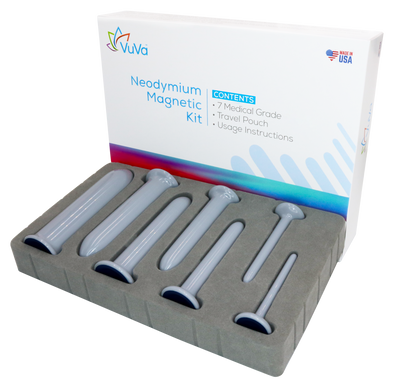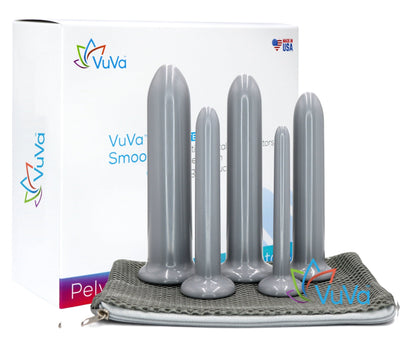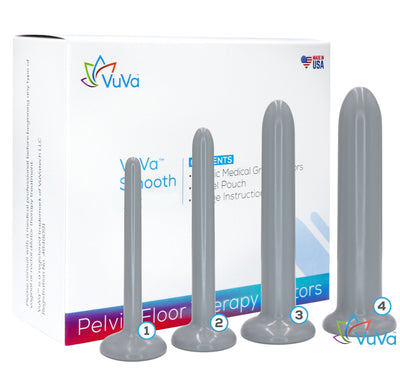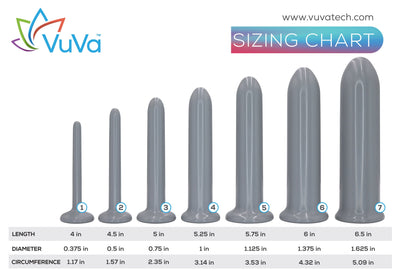
| Tara Langdale
What Are Anal Dilators, Types, and How to Use Them with Instructions
Anal dilators are medical tools used to help with conditions that affect the rectum and anal canal. These tools come in different types and sizes to meet the specific needs of patients. In this blog, we shall discuss what anal dilators are, various conditions they can be used for, and how to use them. Additionally, we shall provide instructions on how to move up to the next size dilator. If you're thinking of using dilators, this comprehensive guide will answer all the questions you have.
What Are Anal & Rectal Dilators?
Anal dilators are tools designed to help stretch and strengthen the anal muscles. They are made of silicone or plastic and come in different shapes and sizes. Plastic dilators create more resistance, which is the purpose of dilating. Typically, dilators are used to treat conditions such as anal stenosis, levator ani syndrome, anal fissures, and hemorrhoids. Dilators are also helpful for people who have undergone colorectal surgery or radiation therapy, which can scar the tissues in the rectum and affect the patient's ability to have bowel movements.
Types of Anal and Rectal Dilators
Rectal dilators are specialized medical anal dilators that are designed to treat conditions involving the rectum. They are made of metal, silicone, or plastic and come in various shapes and sizes. Sturdy medical grade plastic dilators create tension against the muscles. Rectal dilators are widely used to treat conditions such as rectal prolapse, fecal incontinence, and to break up scare tissue. Additionally, they can help improve bowel movements, reduce rectal pain and discomfort, and increase the muscle tone of the rectum.
What are Neodymium Magnetic Anal Dilators?
VuVa Neodymium Magnetic Dilators are a safe and effective home therapy solution for pelvic floor therapy. When you use a VuVa Magnetic Anal Dilator, soft tissue lengthens, relaxing muscles and ligaments. As the tissue relaxes, the Neodymium magnets increase blood flow to the painful area calming nerves. VuVa™ Rectal and Anal Dilators are the only patented dilators available with Neodymium magnets. VuVa has very small rectal dilators to huge rectal dilators.

Rectal Dilators and Their Use in Rehabilitation and Treatment
Rectal dilators are medical devices used to gently stretch and widen the anal canal and rectal muscles. While they can also be used for pleasure, their main purpose is to assist with physiotherapy and rehabilitation for various anorectal conditions.
Managing Chronic Pelvic Pain
Chronic pelvic pain is a common symptom of gynecological issues such as endometriosis, dyspareunia (painful intercourse), vaginismus, or previous cervical cancer surgery. In conjunction with pelvic floor physiotherapy, rectal dilators can be highly effective in relieving chronic pelvic pain by relaxing and stretching tight pelvic muscles. This can make sitting more comfortable and improve overall quality of life.
Soothing Hemorrhoids or Fissures
Hemorrhoids, also known as piles, and anal fissures are common conditions that cause pain in the anus. Hemorrhoids are swollen veins in the lower rectum while anal fissures are tears or cuts in the anal skin. An anal fissure is a small tear in the thin, moist tissue that lines the anus. The anus is the muscular opening at the end of the digestive tract where stool exits the body. Common causes of an anal fissure include constipation and straining or passing hard or large stools during a bowel movement. Anal fissures typically cause pain and bleeding with bowel movements. You also may experience spasms in the ring of muscle at the end of your anus, called the anal sphincter. Both can be painful and uncomfortable, but rectal dilators can help to relax tight muscles and tissues to provide relief.
Relief for Levator Ani Syndrome
Levator ani syndrome is a condition characterized by chronic pain in the anus caused by tight muscles in both the pelvic and anal regions. Symptoms include recurring rectal pain, intense tenderness in the puborectalis muscle, difficult bowel or bladder movements, and pain during sex for women. Using rectal dilators can gradually stretch and relax these muscles to alleviate symptoms.
LAS is a relatively common condition, with an estimated 7-15% of the population experiencing symptoms at some point in their lives. It is more common in women than men, and tends to occur in individuals between the ages of 30-60 years old.
Managing Strictures or Stenosis
Anal stricture, also known as anal stenosis, is a condition where the anal canal becomes narrowed and causes severe pain during bowel movements. This can occur after surgery or radiation treatment for cancer, or as a symptom of Crohn's disease. Rectal dilators can help to prevent this narrowing by relaxing tight anal muscles and allowing the rectum to function properly.
Treating Functional Constipation
Traditionally, physicians have defined constipation as three or fewer bowel movements per week. Having fewer bowel movements is associated with symptoms of lower abdominal discomfort, distension, or bloating. Functional constipation is a chronic condition that involves difficulty passing stool due to an underlying issue. While the cause of functional constipation should be addressed, rectal dilators can provide temporary relief and help heal the anal and rectal muscles.
Post-anorectal Cancer Surgery Rehabilitation
After surgery for anal or colorectal cancer, rectal dilators are often used to rehabilitate the rectal muscles and widen the anal canal. This is important for smooth bowel movements and can also help to massage scar tissue and adhesions caused by radiation treatment.
By gradually stretching the anal and rectal muscles, dilation therapy with rectal dilators can be a beneficial part of rehabilitation and treatment for various anorectal conditions. Consult with a medical professional to determine if rectal dilators may be helpful for your condition.
How To Use Anal Dilators:
The first step in using anal dilators is to consult with a medical professional to ensure that they are suitable for you. Once you have the go-ahead, start by cleaning the dilator using mild soap and water. Lubricate the dilator using a water-based lubricant to make insertion easier. Start with the smallest dilator and gently insert it into the rectum as far as you can tolerate.
Rectal Dilator/Anal Dilator Instructions:
Please consult with a medical professional before beginning any type of treatment or rectal health therapy. You might need different instructions for you condition.
- Wash rectal dilators before use with a mild hypoallergenic soap and warm water.
- Find a comfortable position.
- Many patients prefer to lie on their left side. However, any comfortable position is appropriate.
-
Lubricate both the anal canal and the tip of the dilator. Proper lubrication will help prevent potential tearing or discomfort due to dryness. Do not use a petroleum-based lubricant because it will increase your risk of infection and be more difficult to wash off.
- Insertion. The tip of the dilator should be positioned lightly and at a right angle to the rectum. Exhale and gently ease the dilator into the anal canal. Breathing deeply and inching the dilator deeper with each exhalation will aid penetration.
- Do not continue if you become tense. Practice controlled breathing and attempt to relax. Remove the dilator if there is any chance you might become hurt or injured.
- The dilator is fully inserted once the cuff (the flat end) is in contact with the skin.
- Warning: DO NOT insert dilator completely into rectum.
- Please leave dilator in for recommended time your physician or therapist recommends for your specific condition.
- Wash and dry the dilator thoroughly. Hygiene is important to avoid risk of infection during the next use of the rectal dilator. Use a mild hypoallergenic soap and warm water.
Moving up to the Next Size Dilator:
If you're having difficulty with the next size dilator, try going back to the smaller size and repeating the process. Keep practicing until you can comfortably tolerate the larger diameter dilators. It's crucial to note that the rate at which you increase the size of the dilators varies depending on your body's response. Some people may move up faster than others, while some may take longer.

Understanding Pelvic Floor Rehabilitation: A Comprehensive Approach
Physical therapy is an effective treatment option for individuals experiencing pelvic floor dysfunction. This can include a variety of symptoms such as pain, discomfort, urinary or fecal incontinence, and sexual dysfunction. However, the exact treatment plan will vary depending on each person's specific presentation.
One of the first steps in physical therapy for pelvic floor dysfunction is treating any connective tissue restrictions in the area through connective tissue manipulation. This helps to relax the pelvic floor, increase blood flow, and calm the nervous system. It also lays a foundation for further treatment of underlying trigger points and muscle tightness.
In a typical therapy session, about half of the time will be spent on external work such as trigger point release, and the other half will be dedicated to internal work such as trigger point release and muscle lengthening. Appointments usually last for one hour and patients typically attend 1-2 times per week.
In addition to in-office treatment, your physical therapist will also provide you with an individualized home program based on your specific needs. It is important to consistently follow this program in order to see the best results from your treatment.
It's also important to note that physical therapists do not use a one-size-fits-all approach to pelvic floor rehabilitation. Each patient's treatment will be tailored to their specific needs and may change and evolve as they progress through therapy. Additionally, patients will always have direct supervision from their physical therapist during appointments and will not be left alone with any equipment or exercises. With dedication and a comprehensive approach to pelvic floor rehabilitation, physical therapy can help individuals regain control and improve their quality of life.
Conclusion
In conclusion, anal dilators are medical tools used to treat various conditions that affect the rectum and anal canal. They come in different shapes and sizes and are made of silicone or plastic. Dilators work by stretching and strengthening the affected muscles, leading to improved bowel function. Using anal dilators requires patience, consistency, and a willingness to follow instructions. While choosing between silicone and plastic dilators, plastic dilators are a better option due to their affordability and ease of cleaning. Remember to consult with a medical professional before using dilators to ensure that they are suitable for you.














